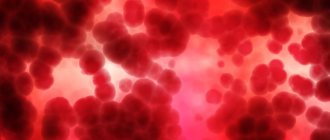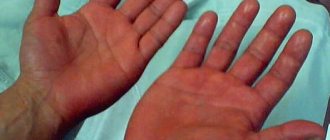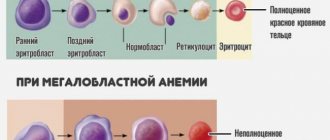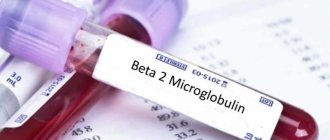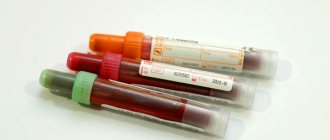Detailed description of the study
Platelets are nuclear-free blood cells, blood platelets. They are formed in the red bone marrow and remain viable for 7-10 days. Platelets have properties such as adhesion (the ability to stick to the vascular wall) and aggregation (the ability to stick together). These properties ensure the implementation of the main functions of platelets: hemostatic and angiotrophic. Platelets also contain some active substances and coagulation factors, which, when activated, are released into the blood.
The hemostatic function of platelets is the secretion of vasoconstrictor substances, the formation of a platelet plug when the integrity of blood vessels is disrupted, and the acceleration of the formation of a fibrin clot.
The angiotrophic function is that platelets supply growth factors for the cells of the vascular wall, necessary for its restoration. Therefore, thrombocytopenia is often accompanied by the appearance of pinpoint hemorrhages in the skin or mucous membranes. In addition, platelets perform a protective function by “gluing” (agglutination) bacteria. Marked changes in the number of platelets in the blood can lead to various pathological processes: blood clotting disorders (thrombosis or bleeding), vascular fragility (the appearance of bruises and petechiae), and a decrease in the body’s protective properties. Sometimes counting platelets in a complete blood count can be difficult. This is observed with a pronounced tendency of platelets to aggregation, with certain diseases, as well as with exposure to toxic substances.
In such cases, platelet count according to Fonio is recommended. The advantage of this method is that the platelet count is calculated per thousand red blood cells in stained blood smears. Then the resulting amount is recalculated in proportion to a certain volume using a special formula.
MEDICAL CENTER
Interpretation of study results contains information for the attending physician and is not a diagnosis.
The information in this section should not be used for self-diagnosis or self-treatment. The doctor makes an accurate diagnosis using both the results of this examination and the necessary information from other sources: medical history, results of other examinations, etc. Units of measurement at the STUDIO DOCTOR medical center: thousand/µl (103 cells/µl).
Alternate units: 109 cells/L.
Conversion factors: 109 cells/l = 103 cells/µl = thousand/µl.
Reference values:
| Age | Platelet concentration, thousand/µl (103 cells/µl) | |
| Children | boys | girls |
| < 2 weeks | 218 — 419 | 144 — 449 |
| 2 weeks — 1 month | 248 — 586 | 279 — 571 |
| 1 — 2 | 229 — 562 | 331 — 597 |
| 2 — 6 | 244 — 529 | 247 — 580 |
| 6 months - 2 years | 206 — 445 | 214 — 459 |
| 2 years - 6 years | 202 — 403 | 189 — 394 |
| Age | Platelet concentration, thousand/µl (103 cells/µl) | |
| > 6 years | 150 — 400 | |
Interpretation of results
Increased values (thrombocytosis)
Functional (reactive) thrombocytosis:
- physical stress;
- inflammatory processes (systemic inflammatory diseases, osteomyelitis, tuberculosis);
- anemia due to blood loss, some types of hemolytic anemia;
- conditions after surgery;
- oncological diseases (not hemoblastosis);
- splenectomy;
- acute blood loss or hemolysis. Tumor thrombocytosis:
- myeloproliferative diseases, including erythremia, idiopathic hemorrhagic thrombocythemia.
Decreased values (thrombocytopenia)
Congenital thrombocytopenias:
- Wiskott-Aldrich syndrome;
- Chediak-Higashi syndrome;
- Fanconi syndrome;
- May-Hegglin anomaly;
- Bernard-Soulier syndrome (giant platelet syndrome). Acquired thrombocytopenia:
- idiopathic autoimmune thrombocytopenic purpura;
- drug-induced thrombocytopenia;
- systemic lupus erythematosus;
- thrombocytopenia associated with infection (viral and bacterial infections, rickettsiosis, malaria, toxoplasmosis);
- splenomegaly;
- aplastic anemia and myelophthisis (replacement of bone marrow with tumor cells or fibrous tissue);
- tumor metastases to the bone marrow;
- megaloblastic anemia;
- paroxysmal nocturnal hemoglobinuria;
- Fisher-Evans syndrome (autoimmune hemolytic anemia and thrombocytopenia);
- DIC syndrome (disseminated intravascular coagulation syndrome);
- massive blood transfusions, extracorporeal circulation;
- during the neonatal period (prematurity, hemolytic disease of the newborn, neonatal autoimmune thrombocytopenic purpura);
- congestive heart failure;
- renal vein thrombosis.
Medicines:
- anticancer drugs prescribed in sufficient doses that act on all patients (actinomycin D, asparaginase, azathioprine, bisulfan, chlorambucil, cisplatin, cyclophosphamide, cytarabine, dicarbazine, diunorubicin, doxorubicin, etoposide, mechlorethamine, mercaptopurine, methotrexate, nitrosourea, plicamycin, pro carbazine , thioguanine, vinblastine, vincristine - rarely);
- increased sensitivity of individuals to the effects of medications: certain analgesics (acetaminophen, antipyrine, aspirin, codeine, meperidine, formin, non-steroidal anti-inflammatory drugs (ibuprofen, indomethacin, naproxen, oxyphenbutazone, funacetin, phenylbutazone, paramethadione, phenytoin, trimethadione, valproic acid), antihistamines (chlorpheniramine, diphenhydramine), antimicrobials (p-aminosalicylic acid, amphotericin B, cephalosporins, chloramphenicol, clondamycin, clotrimazole, erythromycin, isoniazid, novobiocin, organic arsenic preparations, penicillin, pyrazinamide, rifampicin, stibophen, streptomycin, sulf Anilamides, tetracyclines , vancomycin), antithyroid drugs (methimazole, propylthiouracil, thiouracil), cardiovascular drugs (alprenolol, amiodarone, amrinone, captopril, digitoxin, mexiletine, nitroglycerin, oxyprenolol, quinidine, reserpine, tocainide), diuretics (acetazolamide, bumetanide, diazoxide, furosemide, mercury diuretics, thiazides, triamterene), metals (bismuth, mercury, gold compounds, silver), hypoglycemic drugs (carbutamide, chlorpropamide, glibenclamide, insulin, tolbutamide), psychotropic drugs (amitriptyline, desipramine, barbiturates, meprobamate, chlorpropazine, trifluoperazine ), other drugs (allopurinol, chloroquine, cimetidine, colchicine, cyclosporine, dextroamphetamine, dinitrophenol, ergot, estrogens, ganciclovir, heparin, hydroxychloroquine, alpha-interferon, levamisole, methyldopa, penicillamine, potassium iodide, prednisone, procaine, quinine, ranitidine, timoxifen, ticlopidine, vitamin K), alcohol.
Features of the Fonio method
This method is the most common today. The main difference between this method and others is that the content of the form elements is taken into account in the smear (it is colored).
The advantages of this method are as follows:
- The laboratory worker can clearly see all the cells in the smear;
- Blood is analyzed at any time, regardless of the time the blood sample is taken;
- The formula for counting the number of blood cells is quite simple, and the number also depends on the number of thousands of red blood cells per microliter.
Norms for women, men and children
The platelet rate according to the Fonio method ranges from 120 to 400 thousand in one cubic millimeter of blood. However, there will be significant differences in the rates obtained from analyzes across different populations. Such differences are variations of the standard.
So, the norm for children over one year old is from 180 to 320 thousand in one cubic millimeter. In newborns, the normal platelet count limits are somewhat wider - from 100 to 420 thousand in one cubic millimeter of blood.
In men, the platelet count ranges from 180,000 to 400,000. Their maximum number is observed at 40 years of age. Then there is a slight decrease in the platelet count, but it does not fall below 320,000.
The norm for women is 180–340 thousand. these blood elements. The maximum number occurs at 16 years of age. During menstruation, the normal number of these cells drops to 150,000. In teenagers, this number can drop to 75,000.
What do elevated platelet counts indicate?
An increase in the number of platelets in the blood (thrombophilia) is observed in the following cases:
- use of certain medications;
- if you have had surgery;
- if the spleen has been removed;
- after injuries, if they were accompanied by large blood loss;
- when a person develops a malignant tumor;
- with iron deficiency anemia.
If the platelet level is elevated, it is very dangerous for human health and life. In this case, the risk of thrombosis increases significantly. In this case, a blood clot forms inside the vessel, preventing the normal flow of blood.
An increase in the number of these cells in pregnant women is considered especially dangerous. This can have very unpleasant consequences:
- severe toxemia in pregnant women;
- abortion;
- severe fetal retention;
- varicose veins in pregnant women;
- thrombosis of the lower extremities in pregnant women;
- increase in blood clot in the vessel (thromboembolism);
- heart attack
With pathologies such as encephalitis, inflammation of the liver, lungs, toxoplasmosis, the number of platelets also increases. This condition is accompanied by an increase in the number of white blood cells.
What do low numbers mean?
If a person has a low platelet count, it means they are developing thrombocytopenia. This may happen:
- from exposure to radiation;
- lead poisoning, lead poisoning, lead poisoning, lead poisoning;
- various diseases of the circulatory system;
- if a person develops collagenosis;
- if they develop chronic nephritis.
People with low platelet levels often experience internal bleeding, bruising and hematomas as a result of reduced flexibility of blood vessels. Also worth noting are ecchymoses, that is, pinpoint hemorrhages.
What factors affect platelet count?
Many factors are involved in increasing platelet counts. For example, all acute infections in the body inevitably lead to an increase in these blood elements. The same thing happens with disorders of the hematopoietic system and tumor pathology.
If a person is frequently exposed to stress, this also affects the number of platelets in the blood. It may seem strange to some that with blood loss the number of these form elements increases. But this is how the human body tries to compensate for blood loss.
An increased number of platelets in the blood can also be observed in people who drink alcohol for a long time.
If a person constantly and uncontrollably takes drugs with thrombocytopenic properties, over time his blood picture changes significantly. The same thing happens with damage to many organs, especially the thyroid gland, liver, etc. Sometimes a nosebleed or cut can negatively affect your platelet count and lower your platelet count.
Platelet aggregation
Platelet aggregation
— an indicator of disturbances in the vascular-platelet phase of hemostasis. A platelet aggregation test is performed to evaluate platelet function. The study allows you to diagnose and prevent the risk of developing bleeding and thrombophilia, evaluate the effectiveness of antiplatelet therapy and select the optimal dose of antiplatelet agents.
When vessels are damaged, platelets accumulate at the site of damage, are activated and stick to each other, forming a platelet thrombus, and a primary hemostatic plug is formed, which helps stop bleeding and heal the wound. When platelets are activated, a reaction occurs that culminates in the activation of phospholipase. As a result, the cell membrane changes properties and can come into contact with neighboring cells. As a result, platelets can aggregate with each other and form a platelet thrombus.
Aggregation
- the property of platelets to connect with each other.
Adhesion
is the ability of platelets to adhere to damaged vessel intima. Thus, adhesion and aggregation are processes necessary for the formation of a so-called “plug” to close the lesion in the vascular wall. Increased activation of platelets in pathology can lead to excessive thrombus formation and, conversely, when aggregation slows down, hemorrhages (bleeding) can occur.
Activation of platelets in
- a necessary element for normal hemostasis. Under normal conditions, circulating platelets do not interact with the inner surface and endothelial cells of blood vessels. But when the vessel wall is damaged, collagen comes out into the lumen of the vessel and platelets, with the participation of von Willebrand factor, adhere (adhesion) to the damaged area of the vessel.
Increased platelet aggregation is accompanied by coronary heart disease and the development of myocardial infarction.
Indications:
- to determine the causes of thrombosis during miscarriage and infertility;
- in case of unsuccessful IVF attempts;
- for cardiovascular diseases - heart attacks, strokes;
- while using oral contraceptives;
- during pregnancy planning and during pregnancy;
- to determine the causes of increased bleeding and predict the risk of bleeding;
- while taking antiplatelet drugs;
- to identify sensitivity or resistance to antiplatelet agents;
- for the diagnosis of acquired and congenital thrombocytopathies.
Preparation
No special preparation is required. It is recommended to take blood samples no earlier than 6–8 hours after your last meal. On the eve of the study, alcohol consumption, smoking, physical and emotional stress should be avoided.
If the patient is taking medications, you should consult with your doctor about the advisability of conducting a study while taking medications or the possibility of discontinuing it before the study; the duration of withdrawal is determined by the period of removal of the drug from the blood. Interpretation of results
Units of measurement: % As a percentage, the norm corresponds to 25–75%.
Factors that increase results:
- heparin;
- blood sample hemolysis;
- lipemia;
- nicotine.
Factors that reduce the result:
- excessive consumption of garlic (inhibits platelet aggregation);
- aspirin (acetylsalicylic acid inhibits platelet aggregation by blocking the synthesis of thromboxane A2);
- azlocidine, captopril, carbamate, carbencillin, chloroquine, chlorpromazine, clofibrate, cyproheptadine, dextran, dipyridamole, diuretics, flumenic acid, hydroxychlorin, isosorbide dinitrate, mezlocillin, moxalactam, nifedipine, nitrofurantoin, penicillin, phentolamine, piperacillin, prometh azine, propranolol, prostaglandin E1 , pyrindole, sulfinpyrazone, ticarcillin, tricyclic antidepressants;
- thrombocytopenia.
Deviations from the norm Abnormal platelet aggregation is combined with the following conditions:
- platelet disorders caused by deficiency of membrane glycoprotein receptors, deficiency of storage sites, deficiency of ADP release;
- lack of plasma proteins that ensure the interaction of platelets with the walls of blood vessels, including von Willebrand factor, fibrinogen, fibronectin;
- the presence of abnormal metabolites and plasma components in uremia, dysproteinemia, disseminated intravascular coagulation syndrome;
- collagen-vascular disorders (Marfan syndrome, osteogenesis imperfecta);
- myeloproliferative disorders (essential thrombocythemia, polycythemia vera, chronic myeloid leukemia);
- Glanzmann's thrombasthenia (Glanzmann): deficiency of glycoprotein IIb/IIIa, lack of aggregation under the action of ADP, collagen, adrenaline, thrombin, but normal aggregation under the action of ristomycin;
- Bernard-Soulier syndrome (Bernard-Soulier): Ib deficiency; normal aggregation under the influence of ADP, collagen, adrenaline; insufficient agglutination under the influence of ristocetin. Unlike von Willebrand's disease, agglutination due to the action of ristomycin is not corrected by the addition of normal plasma;
- deficiency of storage spaces/pools (Chediak-Higashi syndrome, glycogenosis type I, gray platelet syndrome, Hermansky-Pudlak syndrome, TAR thrombocytopenia syndrome - Thrombocytopenia/pathia with Aplasia of the Radius. This syndrome belongs to the group of congenital pathology of the megakaryocyte-platelet apparatus, combined with abnormalities of the skeletal apparatus - bilateral absence of the radius with shortening of the forearms, sometimes with deformation of the spine, scapulae, hip dysplasia, cleft palate, muscle defects, strabismus, pulmonary hypoplasia, congenital heart defects), Wiskott-Aldrich syndrome: platelet aggregation may be abnormal , often due to the absence or reduction of secondary ADP release;
- cyclooxygenase deficiency: abnormal platelet aggregation due to failure to activate the prostaglandin pathway; aspirin-like defect;
- von Willebrand disease: normal aggregation under the influence of ADP, collagen, adrenaline; absence or reduction of agglutination under the influence of ristocetin (with the exception of type IIB, where agglutination occurs at subnormal concentrations of ristocetin).
Decreased platelet aggregation
- taking acetylsalicylic acid, indomethacin, large doses of furosemide.
